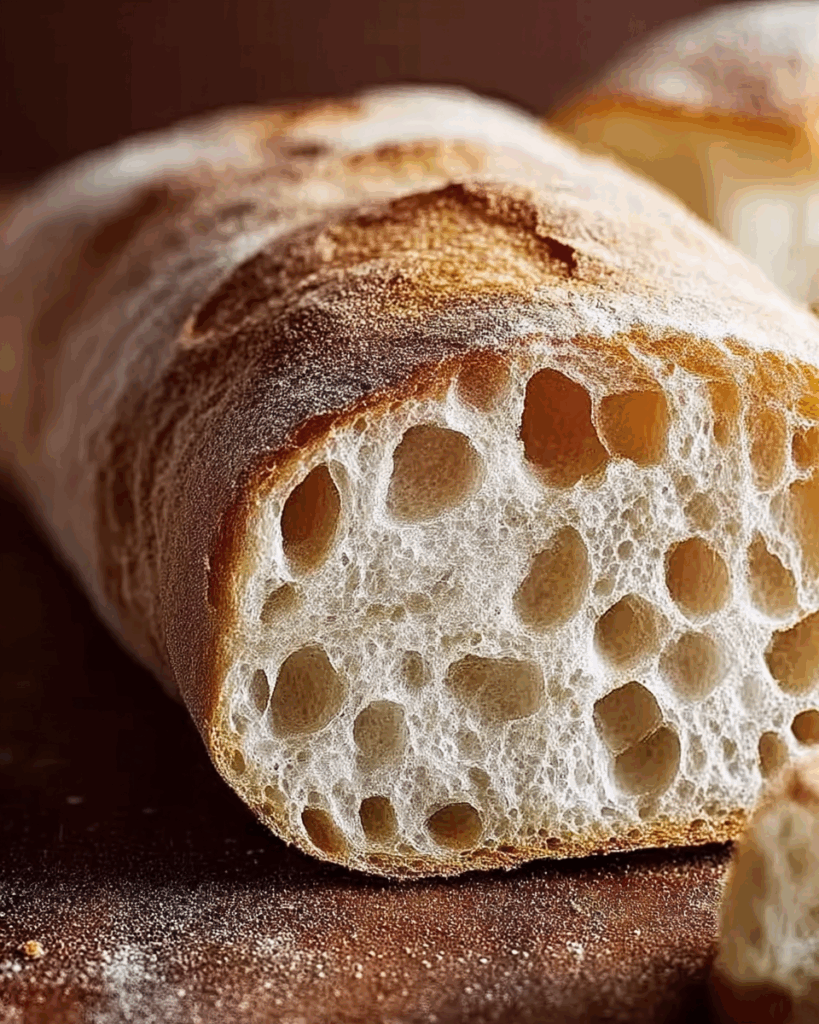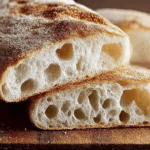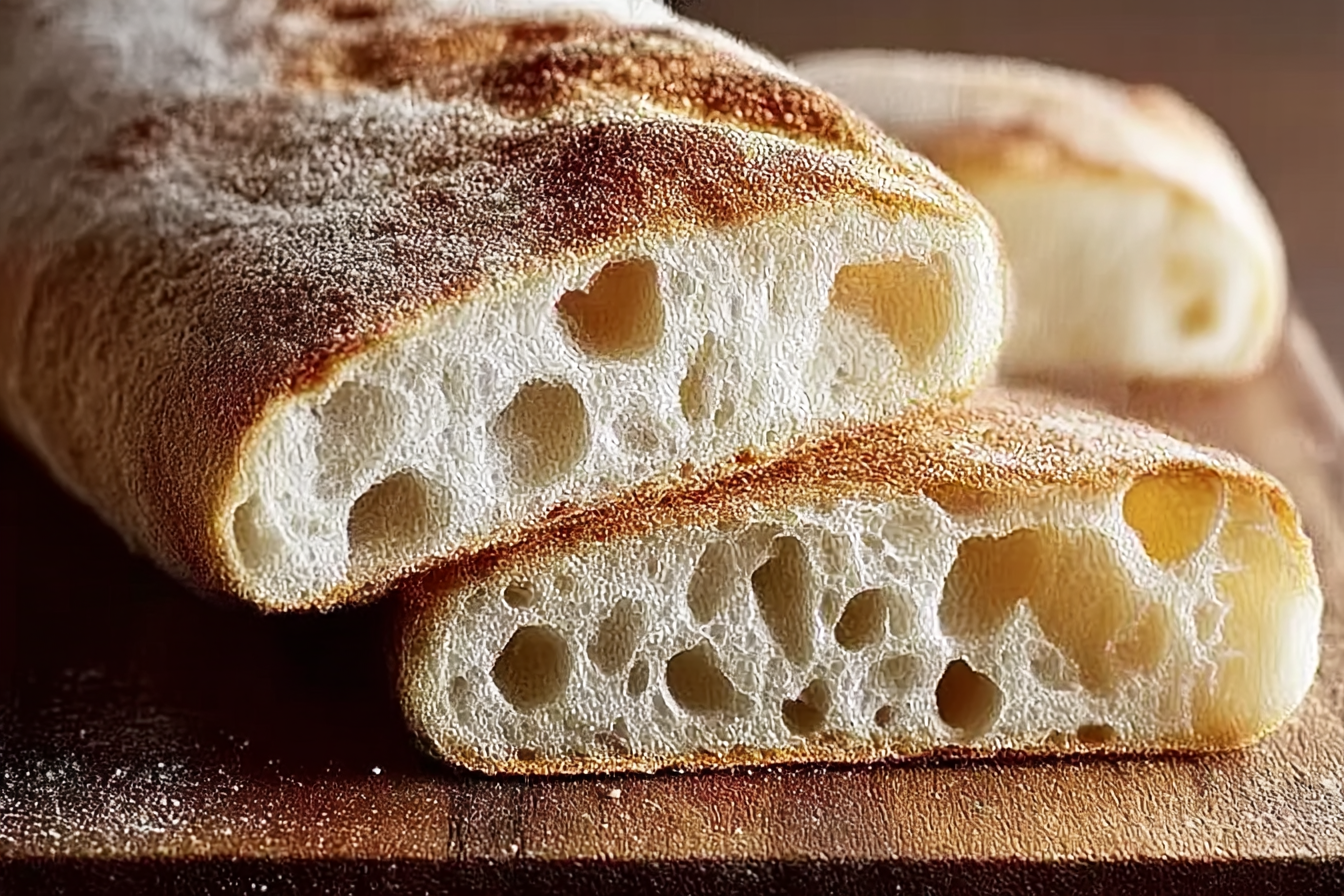There’s something truly magical about pulling a rustic loaf of ciabatta from the oven. Its golden crust crackles at the touch, the interior is airy with those signature open holes, and the aroma of freshly baked bread fills the entire kitchen. Italian Ciabatta Bread is the kind of recipe that transforms a simple day into something extraordinary, reminding you why homemade bread is always worth it. With just a handful of humble ingredients, you can create a loaf that rivals any bakery, ready to be dipped in olive oil or piled high with your favorite fillings.
Behind the Recipe
I first discovered ciabatta while traveling through Northern Italy, where the bread originated in the 1980s. The name literally means “slipper” in Italian, a nod to its flat, elongated shape. What struck me most was how deceptively simple it looked compared to other breads—yet one bite revealed chewy texture, deep flavor, and a lightness that seemed almost impossible. Back home, I set out to replicate that magic, and with a little patience and practice, it became a staple in my kitchen.
Recipe Origin or Trivia
Though ciabatta feels timeless, it’s actually a relatively modern Italian creation. Invented in 1982 by baker Arnaldo Cavallari in Verona, it was Italy’s answer to the popularity of French baguettes. The high hydration dough is what gives ciabatta its trademark airy structure and chewy bite. Today, you’ll find variations across Italy, from ciabatta al latte (with milk) to whole wheat versions, each offering a slightly different personality while staying true to its rustic charm.
Why You’ll Love Italian Ciabatta Bread
This bread isn’t just delicious—it’s a game-changer for your baking routine.
Versatile: Perfect for sandwiches, bruschetta, or simply dunked in olive oil.
Budget-Friendly: Made with just flour, yeast, salt, and water.
Quick and Easy: Minimal ingredients and straightforward steps.
Customizable: Add olives, herbs, or roasted garlic for unique flavors.
Crowd-Pleasing: Everyone loves freshly baked bread.
Make-Ahead Friendly: Dough can be prepped the night before.
Great for Leftovers: Turns into incredible croutons or panini bread.
Chef’s Pro Tips for Perfect Results
These little secrets will make your ciabatta bakery-worthy:
- Hydration is key: The dough will be sticky—don’t panic, that’s what creates the airy crumb.
- Use a bench scraper: It makes handling the sticky dough much easier.
- Don’t over-flour: Too much flour during shaping can weigh the dough down.
- Steam the oven: Place a pan of hot water in the oven to get a crisp crust.
- Let it cool: As tempting as it is, let the bread cool completely before slicing.
Kitchen Tools You’ll Need
Having the right tools makes bread making a breeze:
Mixing Bowl: For combining and resting the dough.
Wooden Spoon or Dough Whisk: To mix the high hydration dough.
Bench Scraper: Essential for handling and shaping.
Kitchen Scale: For precise measurements.
Baking Sheet or Stone: Provides the surface for baking.
Parchment Paper: Keeps the dough from sticking.
Clean Towel or Plastic Wrap: To cover the dough while rising.
Ingredients in Italian Ciabatta Bread
The magic comes from just four simple ingredients working together.
Bread Flour: 4 cups (500 g), provides strength and structure.
Warm Water: 1½ cups (360 ml), key for hydration and open crumb.
Instant Yeast: 2 teaspoons, gives rise and lightness.
Salt: 2 teaspoons, enhances flavor and balances yeast activity.
Olive Oil: 1 tablespoon, optional but adds depth and tenderness.
Ingredient Substitutions
You can adapt this recipe with a few swaps if needed.
Bread Flour: All-purpose flour, though texture may be slightly denser.
Instant Yeast: Active dry yeast (just proof in warm water first).
Olive Oil: Can be omitted or replaced with melted butter.
Warm Water: Room temperature water with a longer rising time.
Ingredient Spotlight
Bread Flour: Higher in protein than all-purpose flour, it creates the strong gluten network needed for ciabatta’s airy structure.
Yeast: The quiet hero that transforms simple flour and water into a pillowy, flavorful loaf.

Instructions for Making Italian Ciabatta Bread
Follow these steps for bakery-style results:
1. Preheat Your Equipment:
Preheat oven to 450°F (230°C). If using a baking stone, place it inside while preheating.
2. Combine Ingredients:
In a large bowl, whisk flour, yeast, and salt. Add warm water and olive oil (if using). Mix until a sticky, shaggy dough forms.
3. Prepare Your Cooking Vessel:
Cover the bowl with a clean towel or plastic wrap and let the dough rest for 1–2 hours, or until doubled in size.
4. Assemble the Dish:
Dust a surface with flour. Use a bench scraper to gently transfer dough. Fold it onto itself a few times to build structure.
5. Cook to Perfection:
Shape into two long loaves and transfer to a parchment-lined baking sheet. Let rest 30 minutes, then bake 20–25 minutes until golden brown with a hollow sound when tapped.
6. Finishing Touches:
Transfer to a wire rack to cool completely before slicing.
7. Serve and Enjoy:
Slice, drizzle with olive oil, or use as a base for sandwiches, bruschetta, or dipping.
Texture & Flavor Secrets
Ciabatta is all about contrasts: a crisp, golden crust that gives way to a soft, chewy interior dotted with airy holes. Its flavor is slightly nutty, mildly tangy, and incredibly satisfying. The long fermentation deepens the flavor, while hi
Print
Italian Ciabatta Bread
Description
Italian Ciabatta Bread is rustic, airy, and delightfully chewy, with a golden crust that crackles at every bite. Made with just four simple ingredients, this homemade bread is perfect for dipping, sandwiches, or simply enjoying warm from the oven.
Ingredients
- Bread Flour: 4 cups (500 g)
- Warm Water: 1½ cups (360 ml)
- Instant Yeast: 2 teaspoons
- Salt: 2 teaspoons
- Olive Oil: 1 tablespoon (optional)
Instructions
- Preheat Your Equipment: Preheat oven to 450°F (230°C). Place a baking stone inside if using.
- Combine Ingredients: In a bowl, whisk flour, yeast, and salt. Add warm water and olive oil. Mix into a sticky dough.
- Prepare Your Cooking Vessel: Cover with a towel or plastic wrap and let rise 1–2 hours until doubled.
- Assemble the Dish: Dust a surface with flour. Transfer dough with a bench scraper and fold gently to build structure.
- Cook to Perfection: Shape into two loaves, place on parchment-lined sheet, rest 30 minutes, then bake 20–25 minutes until golden and hollow-sounding.
- Finishing Touches: Cool on a wire rack completely before slicing.
- Serve and Enjoy: Slice and enjoy with olive oil, soups, or as sandwich bread.
Notes
- Use bread flour for best structure and crumb.
- Don’t over-flour the dough; stickiness is key to texture.
- Spray oven with water or add a pan of water for a crisp crust.
- Cool fully before slicing to avoid a gummy interior.

